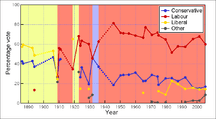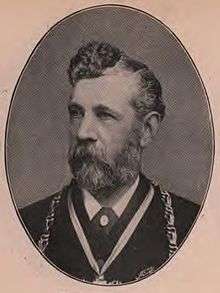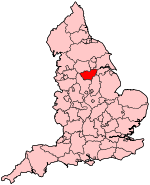Sheffield Attercliffe (UK Parliament constituency)
Coordinates: 53°22′16″N 1°25′41″W / 53.371°N 1.428°W
| Sheffield Attercliffe | |
|---|---|
|
Former Borough constituency for the House of Commons | |
|
Boundary of Sheffield Attercliffe in South Yorkshire for the 2005 general election. | |
|
Location of South Yorkshire within England. | |
| County | South Yorkshire |
| 1885–2010 | |
| Replaced by | Sheffield South East |
| Created from | Sheffield |
Sheffield Attercliffe was a parliamentary constituency in the City of Sheffield. It was created at the 1885 general election and abolished at the 2010 general election, when it was replaced by a new Sheffield South East constituency.
Boundaries
1885-1918: The Municipal Borough of Sheffield wards of Attercliffe and Park, and the civil parish of Heeley.
1918-1950: The County Borough of Sheffield wards of Attercliffe and Darnall.
1950-1955: The County Borough of Sheffield wards of Attercliffe, Darnall, and Handsworth.
1955-1974: The County Borough of Sheffield wards of Attercliffe, Darnall, Handsworth, and Tinsley.
1974-1983: The County Borough of Sheffield wards of Attercliffe, Birley, Darnall, Handsworth, and Mosborough.
1983-2010: The City of Sheffield wards of Birley, Darnall, Handsworth, and Mosborough.
From 1997, Sheffield Attercliffe covered much of the east and south east of the city. It bordered the constituencies of North East Derbyshire, Rotherham, Rother Valley, Sheffield Brightside, Sheffield Central and Sheffield Heeley.
History
Sheffield Attercliffe constituency was created when the two-seat Sheffield constituency was split into five single-member seats in 1885.
Members of Parliament
Elections

Elections in the 2000s
| Party | Candidate | Votes | % | ± | |
|---|---|---|---|---|---|
| Labour | Clive Betts | 22,250 | 60.10 | -7.69 | |
| Liberal Democrat | Kevin Moore | 6,283 | 16.97 | +2.76 | |
| Conservative | Tracy Critchlow | 5,329 | 14.40 | -0.80 | |
| UKIP | Jonathan Arnott | 1,680 | 4.54 | +1.74 | |
| BNP | Beverley Jones | 1,477 | 3.99 | N/A | |
| Majority | 15,967 | 43.13 | |||
| Turnout | 37,019 | 54.59 | |||
| Labour hold | Swing | -5.22 | |||
| Party | Candidate | Votes | % | ± | |
|---|---|---|---|---|---|
| Labour | Clive Betts | 24,287 | 67.8 | +2.5 | |
| Conservative | John Perry | 5,443 | 15.2 | -0.9 | |
| Liberal Democrat | Gail Smith | 5,092 | 14.2 | -1.5 | |
| UKIP | Pauline Arnott | 1,002 | 2.8 | N/A | |
| Majority | 18,844 | 52.6 | |||
| Turnout | 35,824 | 52.9 | -11.7 | ||
| Labour hold | Swing | ||||
Elections in the 1990s
| Party | Candidate | Votes | % | ± | |
|---|---|---|---|---|---|
| Labour | Clive Betts | 28,937 | 65.3 | +7.8 | |
| Conservative | Brendan Doyle | 7,119 | 16.1 | −10.2 | |
| Liberal Democrat | Gail Smith | 6,973 | 15.7 | +1.0 | |
| Referendum | James Brown | 1,289 | 2.9 | N/A | |
| Majority | 21,818 | 49.2 | |||
| Turnout | 44,318 | 64.7 | |||
| Labour hold | Swing | ||||
| Party | Candidate | Votes | % | ± | |
|---|---|---|---|---|---|
| Labour | Clive Betts | 28,563 | 57.5 | ||
| Conservative | Gordon Millward | 13,083 | 26.3 | ||
| Liberal Democrat | Helen Wooley | 7,283 | 14.7 | ||
| Green | Gordon Ferguson | 751 | 1.5 | ||
| Majority | 15,480 | 31.2 | |||
| Turnout | 49,680 | 71.8 | |||
| Labour hold | Swing | ||||
Elections in the 1980s
| Party | Candidate | Votes | % | ± | |
|---|---|---|---|---|---|
| Labour | Patrick Duffy | 28,266 | 57.8 | ||
| Conservative | John Perry | 11,975 | 22.7 | ||
| Social Democratic | Helen Woolley | 9,549 | 19.5 | ||
| Majority | 17,191 | 35.2 | |||
| Turnout | 72.9 | ||||
| Labour hold | Swing | ||||
| Party | Candidate | Votes | % | ± | |
|---|---|---|---|---|---|
| Labour | Patrick Duffy | 23,067 | 51.5 | ||
| Conservative | Gordon Millward | 11,455 | 25.6 | ||
| Social Democratic | Irene Addison | 10,241 | 22.9 | ||
| Majority | 11,612 | 25.9 | |||
| Turnout | 69.7 | ||||
| Labour hold | Swing | ||||
Elections in the 1970s
| Party | Candidate | Votes | % | ± | |
|---|---|---|---|---|---|
| Labour | Patrick Duffy | 29,702 | 64.9 | ||
| Conservative | Douglas French | 11,599 | 25.6 | ||
| Liberal | Dennis Boothroyd | 4,017 | 8.8 | ||
| National Front | J. Mason | 457 | 1.0 | ||
| Majority | 18,103 | 39.6 | |||
| Turnout | 72.7 | ||||
| Labour hold | Swing | ||||
| Party | Candidate | Votes | % | ± | |
|---|---|---|---|---|---|
| Labour | Patrick Duffy | 29,601 | 69.0 | ||
| Conservative | Patricia Santhouse | 8,043 | 18.7 | ||
| Liberal | Gerald Broadhead | 5,282 | 12.3 | ||
| Majority | 21,558 | 50.2 | |||
| Turnout | 67.2 | ||||
| Labour hold | Swing | ||||
| Party | Candidate | Votes | % | ± | |
|---|---|---|---|---|---|
| Labour | Patrick Duffy | 34,120 | 71.9 | ||
| Conservative | Patricia Santhouse | 12,944 | 27.3 | ||
| International Marxist | Tariq Ali | 424 | 0.9 | ||
| Majority | 21,176 | 44.6 | |||
| Turnout | 74.8 | ||||
| Labour hold | Swing | ||||
| Party | Candidate | Votes | % | ± | |
|---|---|---|---|---|---|
| Labour | Patrick Duffy | 26,482 | 69.6 | ||
| Conservative | Patricia Santhouse | 10,986 | 28.9 | ||
| Independent | Percy Sims | 581 | 1.5 | ||
| Majority | 15,496 | 40.7 | |||
| Turnout | 63.4 | ||||
| Labour hold | Swing | ||||
Elections in the 1960s
| Party | Candidate | Votes | % | ± | |
|---|---|---|---|---|---|
| Labour | John Burns Hynd | 32,336 | 77.3 | ||
| Conservative | Brian Marsden | 9,511 | 22.7 | ||
| Majority | 22,825 | 54.5 | |||
| Turnout | 67.6 | ||||
| Labour hold | Swing | ||||
| Party | Candidate | Votes | % | ± | |
|---|---|---|---|---|---|
| Labour | John Burns Hynd | 30,318 | 66.8 | ||
| Conservative | Herbert Lambert | 10,223 | 22.5 | ||
| Liberal | Colin Wood | 4,831 | 10.7 | ||
| Majority | 20,095 | 44.3 | |||
| Turnout | 72.0 | ||||
| Labour hold | Swing | ||||
Elections in the 1950s
| Party | Candidate | Votes | % | ± | |
|---|---|---|---|---|---|
| Labour | John Burns Hynd | 33,676 | 68.8 | ||
| Conservative | Herbert Lambert | 15,304 | 31.3 | ||
| Majority | 18,372 | 37.5 | |||
| Turnout | 75.3 | ||||
| Labour hold | Swing | ||||
| Party | Candidate | Votes | % | ± | |
|---|---|---|---|---|---|
| Labour | John Burns Hynd | 33,071 | 71.0 | ||
| Conservative | Herbert Lambert | 13,503 | 29.0 | ||
| Majority | 19,568 | 42.0 | |||
| Turnout | 72.1 | ||||
| Labour hold | Swing | ||||
| Party | Candidate | Votes | % | ± | |
|---|---|---|---|---|---|
| Labour | John Burns Hynd | 29,958 | 71.1 | ||
| Conservative | Herbert Lambert | 12,161 | 28.9 | ||
| Majority | 17,797 | 42.3 | |||
| Turnout | 82.7 | ||||
| Labour hold | Swing | ||||
| Party | Candidate | Votes | % | ± | |
|---|---|---|---|---|---|
| Labour | John Burns Hynd | 30,726 | 71.6 | ||
| Conservative | Lionel Farris | 12,185 | 28.4 | ||
| Majority | 18,541 | 43.2 | |||
| Turnout | 86.4 | ||||
| Labour hold | Swing | ||||
Elections in the 1940s
| Party | Candidate | Votes | % | ± | |
|---|---|---|---|---|---|
| Labour | John Burns Hynd | 23,468 | 81.4 | ||
| Conservative | Brian Paddon | 5,376 | 18.6 | ||
| Majority | 18,092 | 62.8 | |||
| Turnout | 79.4 | ||||
| Labour hold | Swing | ||||
The 1944 by-election was called following the resignation of Cecil Henry Wilson on 9 February. John Burns Hynd of the Labour Party was elected unopposed.
Elections in the 1930s
| Party | Candidate | Votes | % | ± | |
|---|---|---|---|---|---|
| Labour | Cecil Henry Wilson | 18,663 | 62.8 | ||
| Conservative | Cecil Frederick Pike | 11,034 | 37.2 | ||
| Majority | 7,629 | 25.6 | |||
| Turnout | 73.0 | ||||
| Labour gain from Conservative | Swing | ||||
| Party | Candidate | Votes | % | ± | |
|---|---|---|---|---|---|
| Conservative | Cecil Frederick Pike | 15,185 | 46.0 | ||
| Labour | Cecil Henry Wilson | 15,020 | 45.5 | ||
| Communist | George Fletcher | 2,790 | 8.5 | ||
| Majority | 165 | 0.5 | |||
| Turnout | 78.1 | ||||
| Conservative gain from Labour | Swing | ||||
Elections in the 1920s
| Party | Candidate | Votes | % | ± | |
|---|---|---|---|---|---|
| Labour | Cecil Henry Wilson | 19,152 | 60.3 | -3.3 | |
| Unionist | Wilfred Barnard Faraday | 6,190 | 19.5 | -16.9 | |
| Liberal | Thomas Neville | 4,652 | 14.7 | n/a | |
| Communist | George Henry Fletcher | 1,731 | 5.5 | n/a | |
| Majority | 12,962 | 40.8 | +13.6 | ||
| Turnout | 75.4 | ||||
| Labour hold | Swing | +6.8 | |||
| Party | Candidate | Votes | % | ± | |
|---|---|---|---|---|---|
| Labour | Cecil Henry Wilson | 16,802 | 63.6 | ||
| Conservative | Wilfred Barnard Faraday | 9,629 | 36.4 | ||
| Majority | 7,173 | 27.2 | |||
| Turnout | 75.9 | ||||
| Labour hold | Swing | ||||
| Party | Candidate | Votes | % | ± | |
|---|---|---|---|---|---|
| Labour | Cecil Henry Wilson | 13,581 | 58.7 | -9.5 | |
| Unionist | George Terrell | 6,106 | 26.4 | n/a | |
| Liberal | Harry Anson Briggs | 3,438 | 14.9 | n/a | |
| Majority | 7,475 | 32.3 | -4.1 | ||
| Turnout | 66.8 | -1.8 | |||
| Labour hold | Swing | n/a | |||
| Party | Candidate | Votes | % | ± | |
|---|---|---|---|---|---|
| Labour | Cecil Henry Wilson | 16,206 | 68.2 | ||
| National Liberal | Thomas Worrall Casey | 7,562 | 31.8 | ||
| Majority | 8,644 | 36.4 | |||
| Turnout | 68.6 | ||||
| Labour gain from Liberal | Swing | ||||
Elections in the 1910s

| Party | Candidate | Votes | % | ± | |
|---|---|---|---|---|---|
| Coalition Liberal | Thomas Worrall Casey | 12,308 | 65.3 | ||
| Labour | William Crawford Anderson | 6,539 | 34.7 | ||
| Majority | 5,769 | 30.6 | |||
| Turnout | 52.5 | ||||
| Coalition Liberal gain from Labour | Swing | ||||
The by-election of 1914 was called following the death on 19 November of Joseph Pointer. William Crawford Anderson of the Labour Party was elected unopposed.
| Party | Candidate | Votes | % | ± | |
|---|---|---|---|---|---|
| Labour | Joseph Pointer | 6,532 | 55.0 | ||
| Conservative | Samuel Walker | 5,354 | 45.0 | ||
| Majority | 1,178 | 10.0 | |||
| Turnout | 72.1 | ||||
| Labour hold | Swing | ||||
| Party | Candidate | Votes | % | ± | |
|---|---|---|---|---|---|
| Labour | Joseph Pointer | 7,755 | 56.1 | ||
| Conservative | Sydney Charles King-Farlow | 6,075 | 43.9 | ||
| Majority | 1,676 | 12.2 | |||
| Turnout | 83.9 | ||||
| Labour hold | Swing | ||||
Elections in the 1900s
| Party | Candidate | Votes | % | ± | |
|---|---|---|---|---|---|
| Labour | Joseph Pointer | 3,531 | 27.5 | N/A | |
| Conservative | Sydney Charles King-Farlow | 3,380 | 26.2 | -20.6 | |
| Liberal | Richard Cornthwaite Lambert | 3,175 | 24.6 | -28.6 | |
| Independent Conservative | Arnold Muir Wilson | 2,803 | 21.7 | N/A | |
| Majority | 151 | 1.3 | -5.1 | ||
| Turnout | 77.3 | -1.9 | |||
| Labour gain from Liberal | Swing | N/A | |||
| Party | Candidate | Votes | % | ± | |
|---|---|---|---|---|---|
| Liberal | J. Batty Langley | 6,523 | 53.2 | N/A | |
| Conservative | Arnold Muir Wilson | 5,736 | 46.8 | N/A | |
| Majority | 787 | 6.4 | N/A | ||
| Turnout | 79.2 | N/A | |||
| Liberal hold | Swing | N/A | |||
In the 1900 general election, J. Batty Langley was elected unopposed.
Elections in the 1890s
In the 1895 general election, J. Batty Langley was elected unopposed.
This by-election was called due to the resignation on 26 June of Bernard John Seymour Coleridge following his inheritance of the title of Baron Coleridge.

| Party | Candidate | Votes | % | ± | |
|---|---|---|---|---|---|
| Liberal | J. Batty Langley | 4,486 | 48.6 | ||
| Conservative | G. H. Smith | 3,495 | 37.1 | ||
| Ind. Labour Party | Frank Smith | 1,249 | 13.5 | ||
| Majority | 991 | 10.7 | |||
| Turnout | 79.0 | ||||
| Liberal hold | Swing | ||||
| Party | Candidate | Votes | % | ± | |
|---|---|---|---|---|---|
| Liberal | Bernard John Seymour Coleridge | 5,107 | 56.3 | ||
| Conservative | G. H. Smith | 3,963 | 43.1 | ||
| Majority | 1,144 | 12.6 | |||
| Turnout | 80.2 | ||||
| Liberal hold | Swing | ||||
Elections in the 1880s
| Party | Candidate | Votes | % | ± | |
|---|---|---|---|---|---|
| Liberal | Bernard John Seymour Coleridge | 4,365 | 59.6 | ||
| Conservative | F. W. Maude | 2,958 | 40.4 | ||
| Majority | 1,407 | 19.2 | |||
| Turnout | 75.1 | ||||
| Liberal hold | Swing | ||||
| Party | Candidate | Votes | % | ± | |
|---|---|---|---|---|---|
| Liberal | Bernard John Seymour Coleridge | 4,891 | 57.4 | ||
| Conservative | E. B. Hoare | 3,633 | 42.6 | ||
| Majority | 1,258 | 14.8 | |||
| Turnout | 87.4 | ||||
| Liberal hold | Swing | ||||
See also
Sources
- BBC News, Election 2005
- BBC News, Vote 2001
- Guardian Unlimited Politics
- Leigh Rayment's Historical List of MPs – Constituencies beginning with "A" (part 3)
- http://www.psr.keele.ac.uk/ (Election results from 1951 to the present)
- F. W. S. Craig, British Parliamentary Election Results 1918 - 1949
- F. W. S. Craig, British Parliamentary Election Results 1950 - 1970
- Sheffield General Election Results 1945 - 2001, Sheffield City Council

